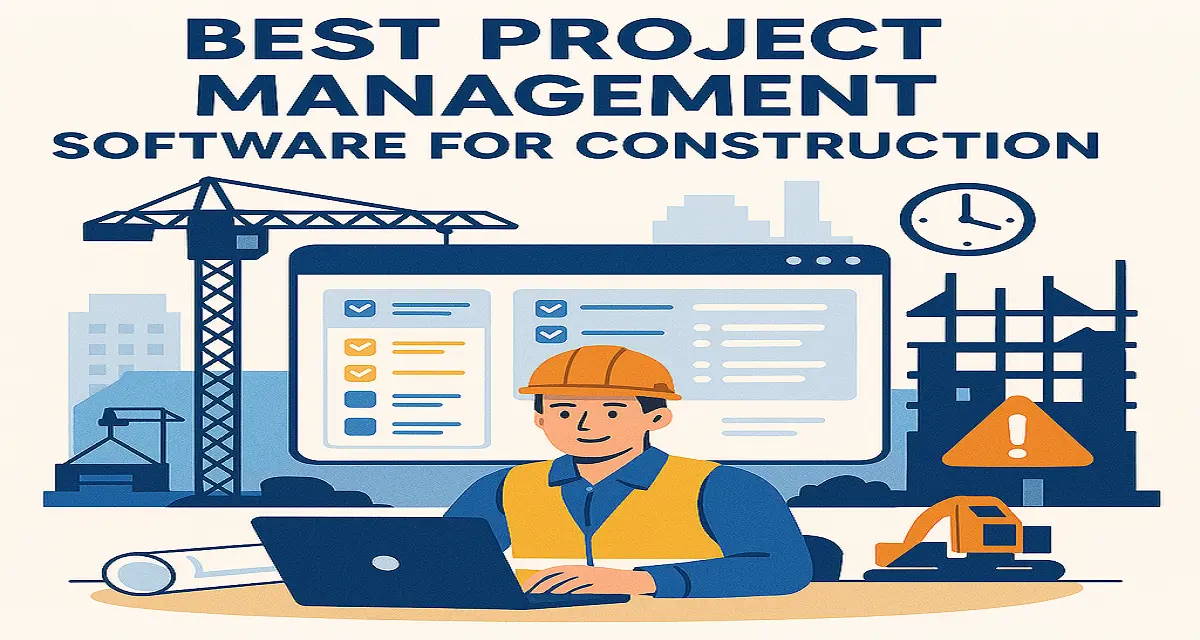This article will discuss the Project Management Software for Construction. Managing construction projects is complicated and requires special tools to ensure that projects stay on track, within budget, and in line to safety and quality standards. The project management software specifically developed for building construction improves coordination, communication, as well as managing resources throughout the entire project’s lifecycle.
This article reviews the top tools for managing construction projects. It also outlines their most important characteristics, their pricing and how they are suitable for various types of construction companies.
Why Use Project Management Software for Construction?
Construction projects require multiple stakeholders: subcontractors, contractors, architects and engineers, suppliers and even clients. The management of this complexity requires a software that is able to handle:
- Task management and scheduling across teams
- Sharing of blueprints and documents with the ability to control version
- Cost tracking and budget tracking
- Collaboration and communication in real-time
- Quality, risk and safety monitoring
- Allocation of resources and equipment
- Analytics and reporting for information on project performance
A specific Software for managing construction projects is adapted to the old PM concepts to meet the unique needs of this industry and replaces manual processes, spreadsheets and other methods of communication that are not connected.
Top Construction Project Management Software in 2025
1. Procore
Summary: Widely regarded as the top construction management system, Procore offers a comprehensive package that covers project management quality and safety finance, field service.
Key Features:
- Centralized document storage, with the ability to control version and share documents easily.
- Tools for collaboration that are real-time, such as RFIs (Requests for Information) and submissions
- Budget management, cost tracking and analytics
- Mobile application for access on-site to updates and plans
- Integration with accounting, scheduling and BIM systems.
Prices: Custom quotes available generally priced per month for each user.
It is ideal for Large and medium-sized construction companies seeking a comprehensive cloud-based platform with robust functionalities for mobile as well as integration.
2. Buildertrend
Summary: Focused on residential builders and remodelers, Buildertrend excels at client communication and transparency, as well as project planning and financial tracking.
Key Features:
- Portals to the client for updates and other options
- A detailed budget and costing of job tools
- Calendar management and scheduling
- Invoicing and generation of proposals
- Mobile application to help field team coordination
Prices: Simple, unlimited pricing model that is specifically designed to residential developments.
It is ideal for Residential contractors and special remodelers who prioritize communication with clients and transparency of the project.
3. Autodesk Construction Cloud (formerly PlanGrid)
Description: Autodesk Construction Cloud integrates construction and design workflows, making it ideal for teams that are leveraging BIM technology and needing close collaboration between construction and design. construction.
Key Features:
- BIM collaboration and tools to detect clashes
- Centralized document management and control of versions
- Analytics for project and reporting advanced
- Variance analysis and tracking costs
- Real-time monitoring of weather conditions and site conditions
Pricing: Custom quotes depending on modules used.
The best choice for Large-scale projects as well as enterprise customers that are focusing on design-build collaboration particularly in areas where BIM is essential.
4. Sage 100 Contractor
Introduction: An on-premise solution used by small to mid-sized contractors. Sage 100 Contractor manages accounting project management, accounting, and estimation under the same under one roof.
Key Features:
- Project portfolio management dashboard
- Tool calibration and equipment monitoring of usage
- Integration with other Sage tools for workflow and accounting
- Management of construction resources, which includes maintenance of equipment
Prices: Pricing available upon the request of.
Ideal for: Small to mid-sized companies that require a powerful, flexible on-premise solutions.
5. RedTeam
Introduction: RedTeam offers tools specifically designed to commercial contractors, which address estimation, project management, and collaboration requirements.
Key Features:
- Project management and estimating integrated
- Change order and contract management
- Portals for collaboration and document control
- Mobile app that provides real-time field updates
Price: Pricing plans start at mid-range and include demonstration and quotes readily available.
Ideal for: Construction teams from the commercial sector requiring complete control of their projects and contracts.
Features to Look For in Construction Project Management Software
When choosing a software program for building construction projects, you should consider the following aspects:
- User-Friendliness: Intuitive interfaces reduce onboarding times and improve the rate of adoption.
- Mobile Accessibility: Field team members require immediate access to data through mobile devices.
- Integration: Link with the accounting system BIM, scheduling and many other tools that are specialized.
- Modification: Capability to modify forms, workflows and reports to meet specific requirements of the project.
- Collaboration: The centralization of communication can reduce errors and delays.
- Price Model: Pricing that is transparent, flexible and that is aligned with the size of the company and project size.
Maximizing ROI with Construction Project Software
To make the most of these platforms:
- Make sure teams are well-trained on the use of software.
- Make use of mobile applications for recording field-based data.
- Establish clear protocols for document version control.
- Review project information regularly to discover bottlenecks as well as cost overruns.
- Choose software that fits your the current requirements, yet able to grow to meet the needs of your business.
Conclusion
In 2025, construction software for managing projects has grown into a vital tool that can increase efficiency, decrease risks, and improve collaboration across all phases of the project. Selecting the best option is dependent on the scope of your project size, the size of the business, and particular industry requirements like BIM integration or communication with clients requirements.
Popular software programs like Procore, Buildertrend, Autodesk Construction Cloud as well as Sage 100 Contractor lead the market, each offering distinct strengths. A careful evaluation of features and prices assures a successful alignment that leads to efficient project execution and growth for businesses.
